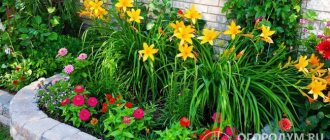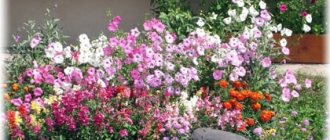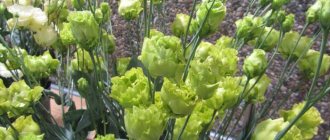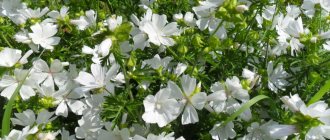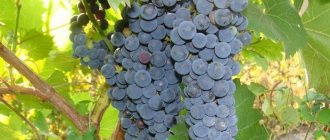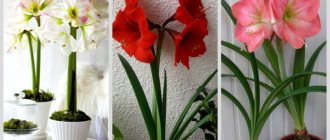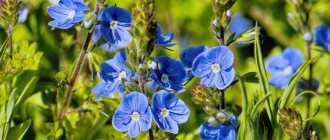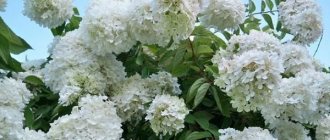Evergreen shrubs
Aucuba
This “golden tree” remains green in any frost and pleases the eye with glossy leaves covered with golden specks. Young seedlings need to be planted at a sufficient distance from each other (from 20 centimeters). The height of the crop reaches from 2 to 4 meters, and for active growth, it needs regular feeding in spring and autumn (at least 5 times a year). In the summer, the bush blooms with discreet but attractive flowers, which in the fall give way to berries.
Photinia
An original shrub that can be planted as a single small tree or created with the help of several seedlings as a hedge. The dark green leaves change color to a rich burgundy color in the fall. Flowering occurs in May-June, during which barely noticeable white flowers, collected in large inflorescences, are replaced by fruits. Easily tolerates temperatures down to -20 degrees and prefers sunny places in important fertile soil.
Holly holly
A fairly tall plant - up to three meters. Large snow-white flowers in autumn are replaced by bright red berries, which completely cover the tree or shrub. The glossy leaves contrast beautifully with the red berries, which is why the plant often becomes a decoration for homes at Christmas; the branches are used to make wreaths and bouquets.
Lavrovishnya
This evergreen shrub is of high value to landscape designers when creating decorative compositions. The plant takes root well in shaded areas with plenty of moisture and, with regular fertilization, pleases with abundant and persistent flowering. The shrub propagates very easily - by cuttings or seeds; it is recommended to plant it in the autumn, a few weeks before serious frosts.
Thuja
Thuja has a variety of varieties, which can be boasted by a small number of plants - about 100 species, but gardeners recommend the Smaragd and Brabant varieties for planting as a hedge. Although the culture belongs to conifers, instead of needles it has soft, pleasant scales that delight with a soft green color all season long. It is important to fertilize the young seedling and choose a sunny place for planting, otherwise the plant will lose its brightness and take a long time to gain growth.
Rhododendron ponticus
Tall, up to 5 meters, shrub with glossy, rich leaves, which in May are complemented by large purple-pink inflorescences. The plant loves fresh and nutritious soil with good drainage properties. It looks quite massive, so it is planted as a hedge, fence or decoration of a house line.
Mahonia holly
Fancy carved leaves attract attention, and golden flowers fill the garden with a lasting vanilla aroma. The shrub grows small - up to one and a half meters. This leafy shrub is one of the few that take root and overwinter in central Russia. Small yellow flowers are collected in fluffy inflorescences and abundantly decorate a small bush in spring.
Features of flower beds made of white perennials
Each color has its own magic, evokes certain emotions and states of mind. But, perhaps, the majority associates only one thing with lightness, elegance, grace and purity - white. Beds of white flowers visually expand the garden area and bring a feeling of lightness and airiness. Landscape designers advise designing them in recreation areas, near a gazebo or pond. Then, during your walks, you will be able to enjoy the magnificence and radiance of white to the maximum, your state of mind will become calmer and more peaceful.
However, it is a mistake to think that designing a one-color flower bed is quite easy. With a competent design approach, you should take into account universal tips for creating flower beds, and recommendations that will help harmoniously embody the idea of monochrome.
When developing a flowerbed plan, you need to take into account the following nuances:
- White flower beds look advantageous against the contrasting background of hedges or trimmed lawns. But you should avoid light-colored buildings and fences.
- When choosing white perennials, you should take into account their requirements for soil quality, lighting, and frequency of watering.
- Perennial plants should make up at least 50% of the total number planted in the flowerbed. Annuals will be an important addition as they have earlier and longer flowering periods.
- The structure of a monochrome flower garden should have 3-4 tiers. In the lower part, decorative grasses should be actively used, and in the highest part, vines, shrubs or trees.
- Plants with different shapes of flowers and leaves should be placed nearby to avoid visual monotony.
- It is recommended to plant at least three specimens of the same species.
- It is necessary to take into account the time of budding of plants. At least two species should bloom in the flowerbed at the same time.
Attention! In the first year, you will only be able to create a “test sketch”. The result can be assessed no earlier than after 2 seasons, and all its splendor can be seen after 3 years.
Flowering shrubs
Jasmine
A spreading shrub that can be presented as a vine, evergreen or deciduous variety. The plant is frost-resistant and does not require special knowledge of care. From June to July it fills the garden with the persistent aroma of jasmine and pleases the eye with large white flowers that completely cover the large bush. The plant is thermophilic and prefers systematic (at least once a week) watering. It can also grow in shaded areas, but this will shorten the flowering period and growth rate.
Derain white
A deciduous shrub that will become an elegant decoration of the garden, even in winter, thanks to the rich burgundy color of the shoots. The plant blooms twice a season and pleases not only with its exquisite flowers that cover the entire upper part of the shoots, but also with white fruits that appear on the branches in the fall. In the autumn, this culture fully reveals its beauty, painting the foliage in all possible colors, fragrant with flowers and fruits. Derain tolerates urban conditions well, does not require fertilizers or special maintenance conditions, and grows quickly and reaches about 5 meters in height.
Deytsia
A long-term garden decoration, it can remain in one place for up to 25 years, without growing - it does not reach a meter in height, and spreading shoots can be trimmed. This culture gives amazing beauty during the flowering period, which occurs at the end of May. Medium-sized flowers are combined into large inflorescences of various shades - from white to red.
Lilac
A fast-growing and flowering shrub, when choosing varieties of which you need to pay attention to several varieties: Meyer, Amur and Hungarian lilacs. These crops are particularly frost-resistant and undemanding in fertilizers. This shrub develops favorably in cities, despite dust and toxic emissions. The flowering period is quite short and lasts no longer than a few weeks. An important fact is the need for annual cutting of root shoots to form foliage in the next season.
Japanese quince (chaenomeles)
The extravagant appearance of this plant will surprise guests and delight the household. Quince begins to bloom in May, and with proper care it will delight you with red-orange flowers until autumn. The flowers are medium in size, up to 8 centimeters in diameter, and are evenly distributed throughout the bush. By autumn, the bush produces nutritious, tasty fruits that are used in medicine and cooking. The sun-loving seedling is resistant to drought and unpretentious from the first years of growth, but it does not bear fruit in a shaded place. The shrub is not large - up to 2 meters in height and spreads shoots closer to the top.
Hydrangea
Some varieties of this famous plant grow as small ornamental shrubs. The plant does not tolerate cold well, so perennials are dug up in November and returned to open ground in May. Seeds are sown at the end of May, when the night frosts have already ended. It is important to water the plant and rid the soil of weeds, and treat the shoots and leaves with pest repellents.
Clematis (Clematis)
A liana shrub that is difficult to trim, but at the same time blooms elegantly and brightly. Flowers have different diameters on one bush - from 8 to 25 centimeters, and also differ in the shape of the inflorescence - star-shaped, bell-shaped, and the petals can be either glossy or double.
Cinquefoil shrub
A compact shrub that landscape designers often use to fence off various flower beds or flower beds on a site. The shrub blooms from early summer until the end of September. The plant is undemanding to soil or fertilizers, but during dry periods it needs abundant watering and spraying. It is also worth considering intolerance to dust and exhaust gases. The variety of varieties offers an abundance of flowering colors to suit every taste.
Rhododendron ponticus
See description above.
Lavrovishnya
See description above.
Mahonia holly
See description above.
Hydrangea
Hydrangea can be considered a classic plant for garden decoration. All representatives of the culture are large in size and require a lot of space for planting. The bush grows not only tall, but also spreading. White varieties include representatives of two varieties of hydrangea - tree and paniculate.
“White lady” and “Grandiflora” look interesting. The inflorescences of the plant are simply gigantic in size - up to 25 cm. The plant blooms in mid-summer and continues to bloom until frost. In winter, it is better to cut off the inflorescences, since under the weight of snow they can break off, damaging the shoots.
The blossoming flowers are initially snow-white in color, and then acquire a greenish tint. A prerequisite is planting in acidic soil. It is advisable that on the north side the bush is protected from the wind by buildings or a fence. Hydrangeas also like the sun.
Shrubs that do not require cutting
Snowberry
A honeysuckle shrub with bluish-green leaves that contrast with the large pinkish flowers. The crop does not grow more than 130 centimeters and is not suitable for decorating the area with figured plantings, since the shoots are difficult to tolerate cutting. But it is recommended to remove faded flowers for further formation of buds.
Dogwood
A feature of the shrub is the seasonal change in leaf color. In spring and summer, the foliage is green, and starting in autumn, the color changes to yellow, and later to deep purple. The shrub will grow quietly in the shade, in any type of soil, but for abundant growth it is recommended to fertilize the soil when planting. To plant a hedge, you should not take an adult plant (up to 3 years old). The plant grows up to 30 centimeters per year.
Clematis (Clematis)
See description above.
Boxwood
This small and compact shrub attracts designers and gardeners with its unusual leaf shape, reminiscent of four-leaf clovers, and its ease of care. The plant will not require special choice of location or soil, but will prefer infrequent watering during dry periods. As the shrub grows, it creates a dense, but not high hedge (in the first 5 years it adds 10-20 centimeters in height), which independently acquires the correct geometric shape, requiring almost no pruning or trimming.
Faulkner Boxwood, Buxus 'Faulkner', at Visalia CA USA Faulkner Boxwood, Buxus 'Faulkner', at Visalia CA USA
Kalmiya
This shrub will be loved by many for its lack of need for cutting and caring for shoots. It is recommended to plant the crop in partial shade, without direct sunlight and without stagnant water in the soil. The plant blooms profusely - the color and timing of flowering directly depends on the variety and care. It is important to plant young seedlings at a sufficient distance from each other (50-60 centimeters), since the shoots grow quickly and interfere with the normal growth of neighboring bushes.
Basic selection rules
As can be seen from the above, the variety of types of shrubs provides the gardener with a wide range of opportunities for decorating a personal or garden plot. But how to choose a plant so that all the work on planting and caring for the seedling is not in vain. The most important requirements:
- compliance with the climatic zone;
- low maintenance requirements;
- availability of sufficient free space.
Most of the shrubs listed above retain their decorative value throughout the year thanks to their lush flowering, delicacy and brightly colored leaves. And some do not lose their aesthetics even after the leaves fall, pleasing the eye with bright fruits and berries.
Shrubs with decorative leaves
Common hazel
An unusual variety of hazel, which is famous for its beautiful crown, unusual color and shape of leaves. Shrubs with white-variegated or purple leaves stand out in an original way against the background of general greenery in the summer, and withstand the first frosts. The plant is demanding on soil - it requires moist and fertile soil, and immediately after planting it is necessary to fertilize the root system. At the same time, it does not tolerate waterlogging and salinity.
Japanese maple
Large perennial, growing up to 10 meters. The main decoration is a spreading, luxurious crown, which, depending on the variety, can be pink, crimson, green or gold. Even after the leaves fall in the fall, maple looks impressive thanks to its sophisticated shoots.
Shaina
Silver sucker
An unpretentious perennial shrub that can grow in one place for more than 20 years. With proper care, it takes the form of a tree with snow-white leaves, which serve as decoration until the end of autumn.
Boxwood
See description above.
Euonymus
An unpretentious crop, famous for its spreading, rich red crown, which gains color closer to the autumn period. So, when all the greenery falls and loses its attractiveness, the euonymus begins to shine and becomes the pearl of the garden. The shrub tolerates shearing calmly and recovers quite quickly, so it is actively used to create hedges and borders, since the crown can retain the shape given to it during shearing for a long time.
Bladderwort
One of the most common shrubs among gardeners and landscape designers. The hedge is loved for its unpretentious character and abundant growth, which reaches 4-6 meters. Rich dark purple leaves have an attractive appearance until the September frosts. The vesicle plant is easy to arrange even for a simple gardener, since the shoots are erect, easy to trim, and the leaves quickly regenerate.
Pansy (viola)
Viola is found in meadows and forest edges. In nature, the flowers are small, but the selected varieties are distinguished by larger flowers and amaze with the palette of colors. Often, one plant has 2-3 colors combined in the color of its petals, which gives the compact plant a special sophistication.
Try proven varieties from a trusted supplier:
